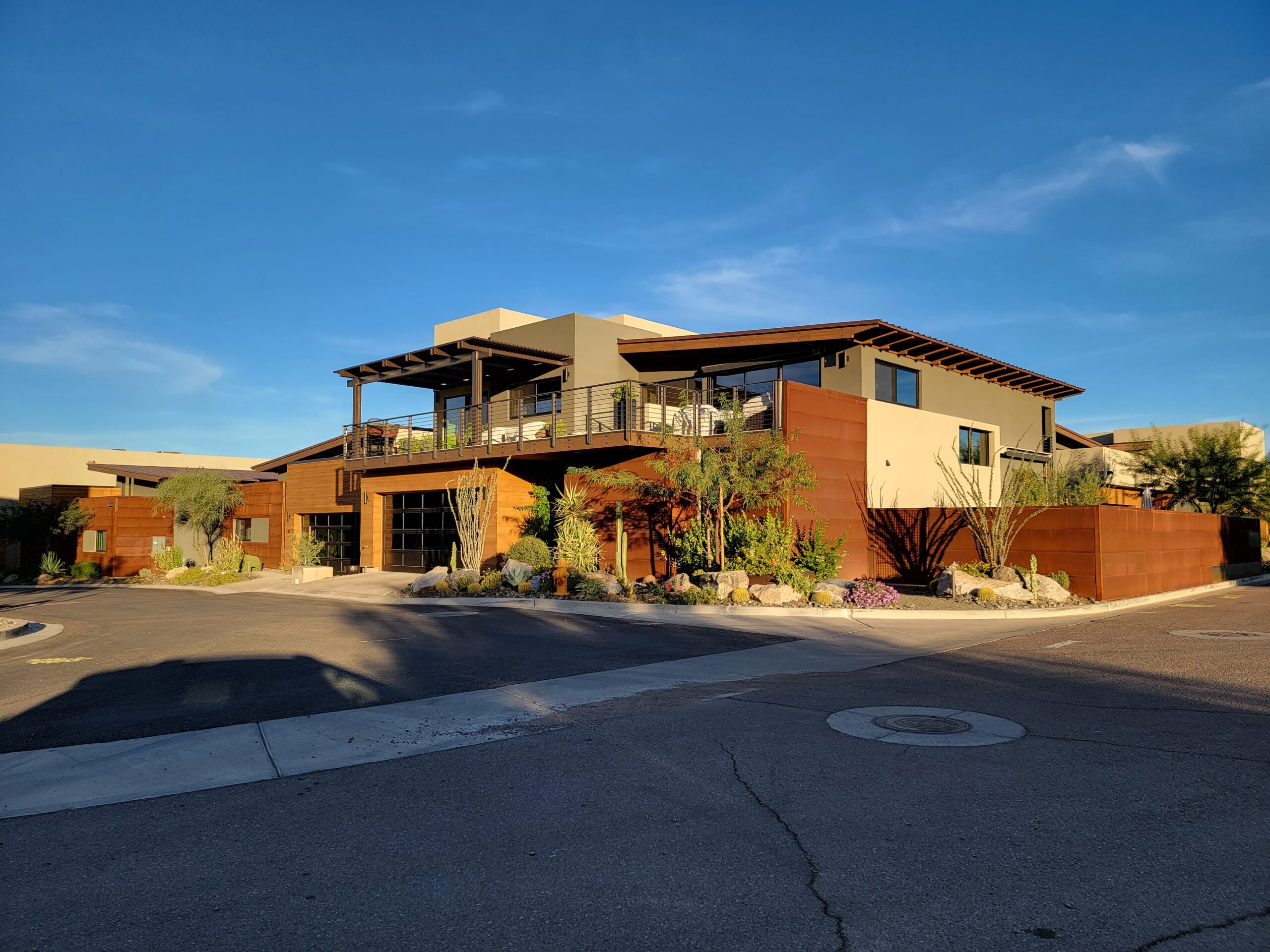A form of real estate ownership of a multifamily residential dwelling. Each occupant has 100% ownership of his own apartment and partial ownership of common elements such as hallways, elevators, plumbing, etc. Also see cooperative.
This article refers to a form of housing. For information on the international law describing a territory in which two sovereign powers have equal rights, please see condominium (international law).
A condominium, or condo for short, is a form of housing tenure. It is the legal term used in the United States and in most provinces of Canada for a type of joint ownership of real property in which portions of the property are commonly owned and other portions are individually owned. In Australia and the Canadian province of British Columbia, the legal term for this is strata title. In Quebec, it is known as syndicates of co-ownership. In England and Wales the equivalent is common hold, but this form of ownership was only introduced in 2004 and so far is hardly used. Colloquially, the term “condo” is often used to refer to the apartment unit itself in place of the term “apartment”. This clearly signifies ownership of the property.
Discussion
Often, a condominium consists of units in a multi-unit dwelling (i.e., an apartment or a development) where each unit is individually owned and the common areas such as hallways and recreational facilities are jointly owned (usually as “tenants in common”) by all the unit owners in the building. It is possible, however, for condominiums to consist of single family dwellings: so-called “detached condominiums” where homeowners do not maintain the exteriors of the dwellings, yards, etc. or “site condominiums” where the owner has more control and possible ownership (as in a “whole lot” or “lot line” condominium) over the exterior appearance. These structures are preferred by some planned neighborhoods and gated communities.
A homeowners association, consisting of all the members, manages the common areas usually through a board of directors elected by the members. The same concept exists under different names depending on the jurisdiction, such as “unit title”, “sectional title”, “common hold,” “strata council,” or “tenant-owner’s association”, “body corporate”, “Owners Corporation”, “condominium corporation” or “condominium association.” Another variation of this concept is the “time share” although not all time shares are condominiums, and not all time shares involve actual ownership of (i.e., deeded title to) real property. Condominiums may be found in both civil law and common law legal systems as it is purely a creation of statute.
The rules for condominium government or management are established in a document commonly called a declaration of condominium. The owners and occupiers of condominiums are subject to rules in the declaration of condominium or created by the condominium association, such as paying required monthly fees for maintaining the property’s common areas. Condominiums are commonly owned in fee simple title, but can be owned in ways other real estate can be owned, such as title held in trust. In some jurisdictions, such as Ontario, Canada, there are also “leasehold condominiums” where the development is built on leased land.
In general, condominium unit owners can typically rent their condominiums to other people to occupy as tenants, similar to renting out other real estate, although such leasing rights may be subject to conditions or restrictions set out in the condominium declaration or otherwise as permitted by law applicable in the jurisdiction.
Non-residential condominiums
Condominium ownership is also used, albeit less frequently, for non-residential land uses like offices, hotel rooms, retail shops, and group housing facilities like retirement homes or dormitories. The legal structure is the same, and many of the benefits are similar; for instance, a nonprofit corporation may face a lower tax liability in an office condominium than in an office rented from a taxable, for-profit company. However, the frequent turnover of commercial land uses in particular can make the inflexibility of condominium arrangements problematic.
United States
New luxury Aqua waterfront condos in Long Beach, California
An alternative form of ownership, popular in the United States but found also in other common law jurisdictions, is the “cooperative” corporation, also known as “company share” or “co-op”, in which the building has an associated legal company and ownership of shares gives the right to a lease for residence of a unit. Another form is leasehold or ground rent in which a single landlord retains ownership of the land on which the building is constructed in which the lease renews in perpetuity or over a very long term such as in a civil law emphyteutic lease. Another form of civil law joint property ownership is undivided co-ownership where the owners own a percentage of the entire property but have exclusive possession of a specific part of the property and joint possession of other parts of the property; distinguished from joint tenancy with right of survivorship or a tenancy in common of common law.
The first condominium law passed in the United States was passed by the Commonwealth of Puerto Rico in 1958. Common law tradition holds that real property ownership must involve land, whereas the French civil law tradition recognized condominium ownership as early as the 1804 Napoleonic Code; thus, it is notable that condominiums evolved in the United States via a Caribbean government with a hybrid common-civil legal system. In 1960, the first condominium in the Continental United States was built in Salt Lake City, Utah. Initially designed as a housing cooperative (Co-op), the Utah Condominium Act of 1960 made it possible for “Graystone Manor” (2730 S 1200 East) to be built as a condominium. The legal counsel for the project, Keith B. Romney is also credited with authoring the Utah Condominium act of 1960. Romney also played an advisory role in the creation of condominium legislation with every other legislature in the U.S. Business Week hailed Romney as the “Father of Condominiums”. He soon after formed a partnership with Don W. Phil called “Keith Romney Associates”, which was widely recognized throughout the 1970’s as America’s preeminent condominium consulting firm. [1] Although often mistakenly credited with coining the term “Condominium“, Romney has always been quick to point out that the term hails back to Roman times, and that he merely borrowed it.
Section 234 of the 1961 National Housing Act allowed the Federal Housing Administration to insure mortgages on condominiums, which led to a vast increase in the capital available for condominiums and to condominium laws in every state by 1969. Americans’ first taste of condominium life came not from its largest cities but from south Florida, where developers had first imported the condominium concept from Puerto Rico and used it to sell thousands of inexpensive apartments to retirees arriving with equity earned from the urban North.
Canada – Ontario
In Ontario, condominiums are governed by the Condominium Act, 1998 with each development establishing a corporation to deal with day-to-day functions (maintenance, repairs, etc…). A board of directors is elected by the owners of units (or, in the case of a common elements condominium corporation, the owners of the common interest in the common elements) in the development on at least a yearly basis. A general meeting is held annually to deal with board elections and the appointment of an auditor (or waiving of audit). Other matters can also be dealt with at the Annual General Meeting, but special meetings of the owners can be called by the board and, in some cases, by the owners themselves, at any time.
In recent years the condo industry has been booming in Canada, with dozens of new condo towers being erected each year. Toronto is the epicenter of this boom, with 17,000 new units being sold in 2005, more than double second place Miami’s 7,500 units [1]. For several years now that city’s sky line has had a forest of cranes erecting new towers. Outside of Toronto, the most common forms of condominium have been townhomes rather than high-rises, although that trend may be altered as limitations are placed on “Greenfields” (see Greenfield land) developments in those areas (in turn, forcing developers to expand upward rather than outward and to consider more condominium conversions instead of new housing). Particular growth areas are in Kitchener Waterloo and London. In fact, after Toronto, the Institute is one of that organization’s most thriving chapters.
The Ontario Condominium Act, 1998 provides an effectively wide range of development options, including Standard, Phased, Vacant Land, Common Element and Leasehold condominiums. Certain existing condominiums can amalgamate, and existing properties can be converted to condominium (provided municipal requirements for the same are met). Accordingly, the expanded and expanding use of the condominium concept is permitting developers and municipalities to consider newer and more interesting forms of development to meet social needs.
On this issue, Ontario condominium lawyer Michael Clifton writes, “Condominium development has steadily increased in Ontario for several years. While condominiums typically represent attractive lifestyle and home-ownership alternatives for buyers, they also, importantly, introduce a new approach to community planning for home builders and municipal approval authorities in Ontario. …[There are] opportunities for developers to be both creative and profitable in building, and municipalities more flexible and imaginative in planning and approving, developments that will become sustainable communities.” (In, A Comment about Condominiums, Community Planning and Sustainability, Forum Magazine, Dec 06/Jan 07, p. 28.)
See also
- Dockominium, a water-based version
- Car condo
- Commonhold
- Condo Conversion
- Housing cooperative
- Strata title
References
- Condominium Property Act – Alberta
- Condominium Act – Ontario
- Luxury Condominiums
- Consumer Protection – Condos – Government of Ontario web site
- Essential Issues For Realtors, in the Condominium Act 1998. by Craig Robson, Michael Clifton and Ron Danks (published by the trade organization CCI-Golden Horseshoe Chapter)
- A Planners’ and Municipalities’ Guide To The Condominium Act, 1998. By Craig Robson, Michael Clifton, Greg Carpenter, Ron Danks and Avril Lavallee (published by the trade organization CCI-Golden Horseshoe Chapter)
- Robert H. Nelson, Private Neighborhoods and the Transformation of Local Government (Urban Institute Press, 2005)





